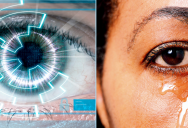A Smart Contact Lens Powered By Human Tears Is Currently Being Developed

Crying is therapeutic, it’s a sign that you’re alive, and it’s nothing to be ashamed of – and apparently, they can power the contact lenses of the future.
A team of researchers from Singapore has invented a micrometer-thin battery that stores energy in the form of human tears. They then use this battering to power smart contact lenses.
Smart contact lenses are still theoretical at the moment, but would (in theory) allow users to get directions, read notifications, or check other simple data without glasses, our phones, watches, etc.

Figuring out how to power these lenses has been a huge hurdle up to this point, as tiny batteries have stumped the most creative of inventors.
Lee Seok Woo, lead author of this new paper, says they’re excited about the prospects of their new, tear-powered battery.
“This research began with a simple question: could contact lens batteries be recharged with our tears? Yes. It relies on just glucose and water to generate electricity, both of which are safe to humans and would be less harmful to the environment when disposed, compared to conventional batteries.”
The battery they have conceptualize is thinner than a single millimeter, is made from biocompatible materials, and uses a glucose-based reacting with sodium and chloride ions to generate electricity and power a circuit.

Those elements are conveniently found in tears.
Their experiments involved a simulated eye, and found that the battery produced a current of 45 microamperes at an output of 201 microwatts.
Experts say this is enough to power a smart contact lens and study co-author Li Zongkang, agree.
“Although wireless power transmission and supercapacitors supply high power, their integration presents a significant challenge due to the limited amount of space in the lens. By combining the battery and biofuel cell into a single component, the battery can charge itself without the need for additional space for wired or wireless components.”
The tech is a long way from mass production or even human testings, but the battery results are a huge leap forward.
With the new excitement and the financial support of contact lens companies, though, it shouldn’t be long until we hear more about it.

Sign up to get our BEST stories of the week straight to your inbox.




